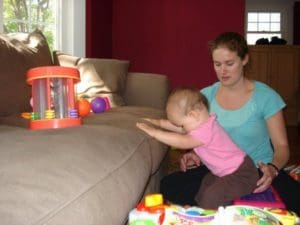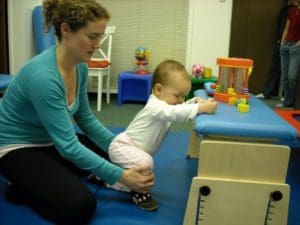Learning to pull to stand can come naturally for some kids, and for others it can require a bit of work. This video is one where it came naturally (please note the emerging balance reactions at the end of the video – I love to see kids getting to experiment with this). As he was learning to crawl and explore he naturally began experimenting with pushing or pulling up to stand. This may have started with your legs, a coffee table, an oversized bin, the couch, or a chair. Basically anything that is off the ground and their hands can reach. When they get to it, their natural curiosity has them try to see what’s up there, or what’s on the other side. They become successful at it when the ability of their muscles matches their curiosity!
For those kids that require a little more help, here are some ideas you can try:
- Sit to Stand – If your child can already sit independently, have them sit on a small stool really close to the couch or an activity table or a chair. Have a preferred toy or activity on the support surface. Help them to put their hands on the support surface and move into standing. Let them play for a bit and then bring them back down into sitting and repeat again. This helps them to strengthen their leg muscles, as well as learn that if they move into the new position, there might be something they like there!
- Playing at Support Surfaces of Various Heights – When your child can crawl, or even kneel, create an environment where they have different heights to explore on. This could be the couch, the coffee table, an activity table, an overturned storage bin, a foot stool, etc. Put toys or activities that are motivating to the them on the support surfaces, and be there to engage as well. They may begin to experiment with pushing or pulling up onto extended legs. You can also line them up near each other. For instance, have the activity table touching the couch and a little bit away have an overturned bin touching the couch so that you have made a U of activities at various heights. Let them start at the lowest height and then make them aware of the activities or toys at the higher height. They can use the lower height to help them problem solve how to reach the higher height. This can also help them learn how to lower back down to the ground because they may want to get back to the toy or activity at the lower height again.
- Crawling Over Obstacles – Learning to crawl over obstacles helps kids to develop their total body strength as well as have to problem solve how to get to where they want. This can involve pushing up onto extended legs before they go over the obstacle, or even just crawling right over. It engages their curiosity about what is ‘on the other side’ and if you use toys that are motivating, they can crawl back and forth along the same obstacle path for many repetitions! Use your legs, couch pillows, piles of blankets or towels, small upside down storage containers, etc.
- Manual Assistance – And sometimes you just have to give them the extra support and take them through the motions. So if you are at a support surface, and they are on their knees with their hands on the surface, help them bring one leg forward so their foot is resting on the floor (half kneel) and then give them a little boost at the hips to go all the way up into standing. Take turns with which side you help them with so they get to develop strength in both legs, as well as so that each leg learns that it can push without the other leg right next to it!
What are other ways you have taught kids to pull to stand?

